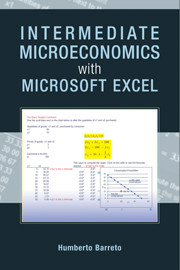Book contents
- Frontmatter
- Contents
- Preface
- User Guide
- Introduction
- PART I THE THEORY OF CONSUMER BEHAVIOR
- 1.1 Budget Constraint
- 1.2 Satisfaction
- 1.3 Optimal Choice
- 1.4 Comparative Statics
- 1.5 Endowment Model
- 1.6 Bads
- 1.7 Search Theory
- 1.8 Behavioral Economics
- PART II THE THEORY OF THE FIRM
- PART III THE MARKET SYSTEM
- Conclusion
- Index
1.2 - Satisfaction
from PART I - THE THEORY OF CONSUMER BEHAVIOR
Published online by Cambridge University Press: 05 June 2012
- Frontmatter
- Contents
- Preface
- User Guide
- Introduction
- PART I THE THEORY OF CONSUMER BEHAVIOR
- 1.1 Budget Constraint
- 1.2 Satisfaction
- 1.3 Optimal Choice
- 1.4 Comparative Statics
- 1.5 Endowment Model
- 1.6 Bads
- 1.7 Search Theory
- 1.8 Behavioral Economics
- PART II THE THEORY OF THE FIRM
- PART III THE MARKET SYSTEM
- Conclusion
- Index
Summary
[Indifference] curves are negatively sloped, pass through every point in commodity space, never intersect, and are concave from above. The last-mentioned property implies that the marginal rate of substitution of X for Y diminishes as X is substituted for Y so as to maintain the same level of satisfaction.
C. E. FergusonThe key idea is that every consumer has a set of likes and dislikes, desires, and tastes, called preferences over all goods and services.
Preferences allow the consumer to compare any two combinations or bundles of goods and services in terms of better, worse, or the same. The result of such a comparison can be described as follows:
Strictly preferred – the consumer likes bundle A better than bundle B
Indifferent – the consumer is equally satisfied having bundle A or bundle B
Weakly preferred – the consumer likes bundle A better than bundle B or is indifferent between them
In terms of algebra, you can think of strictly preferred as greater than (>), indifferent as equal (=), and weakly preferred as greater than or equal (≥).
If the consumer can rank any two bundles, then by repeated comparison of different bundles the consumer can rank all possible combinations from best to worst.
The consumer's preferences can be revealed and mapped by having her choose between bundles.
Three Axioms
Three fundamental assumptions are made about preferences to ensure internal consistency:
1. Completeness – the consumer can compare any bundles and render a preferred or indifferent judgment.
2. Reflexivity – this identity condition says that the consumer is indifferent when comparing a bundle to itself.
3. […]
- Type
- Chapter
- Information
- Intermediate Microeconomics with Microsoft Excel , pp. 17 - 36Publisher: Cambridge University PressPrint publication year: 2009



